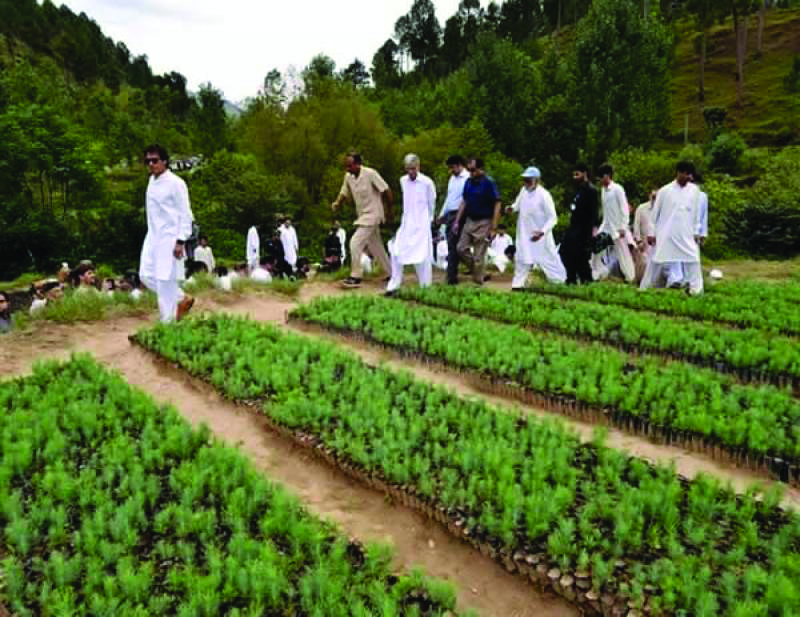ISLAMABAD: Will it be tree shelter that will eventually rescue the faltering regime?
The rapid rate at which the challenges are mounting for the PM Imran Khan-led Pakistan Tehreek-e-Insaf government, it may soon witness a scenario where the members of the ruling part will be seen scurrying for refuge under a thick foliage somewhere. But the question is, are there enough trees in place to save them from the scorching heat that is threatening to burn down the PTI’s many tall claims made during its three years in office.
It is no secret now that people of Pakistan are gradually getting convinced that PTI has mishandled almost all the key issues confronting the state today including governance, economic viability, the rising inflation, the foreign policy, law and order, legislation and so many other. However, the government, in a rare show of consistency, appears well on track to achieve its billion-tree campaign, aimed at countering the global warming threat in the region.
According to the data obtained by Bol News recently, the federal government’s major initiative of planting 10 billion trees is going smoothly in its first phase as 1.329 billion trees have already been planted across the country. However, there are indeed some grey areas in this campaign which mostly pertain to the selection of the kind of trees that are being planted under this project.
An international consortium consisting of environmental protection agencies, in its report on the monitoring and evaluation of Ten Billion Tree Tsunami Project (TBTT), has pointed out grey areas such as lack of focus on restoration of landscapes, ecology and biodiversity in the campaign.
The TBTTP Programme is a government of Pakistan initiative which is being implemented by the Ministry of Climate Change (MoCC), with the support of provincial forests and wildlife units. The MoCC is overseeing TBTTP including doing coordination, execution, supervision, and overall delivery of the program outputs and activities.
Federal Minister for Planning Asad Omar recently said that the tree plantation campaign is inspiring for whoever is following it and coming in contact with it. “275,000 trees will be planted in the federal capital Islamabad,” said Omar while addressing the inaugural campaign of Miawa Forest. “The students of educational institutions and madrassas are also planting trees. The campaign will surely benefit the next generation.”
Reports suggest that Pakistan is among the most vulnerable countries on the Global Climate Index which has been recurrently impacted by catastrophes, made worse by the deteriorating climatic conditions. This project aims to minimize the impact of environmental changes in the country.
The TBTTP Phase-I which is in progress is a four-year (2019-2023) project by Government of Pakistan which is being materialized with the total cost of Rs 125.1843 billion. The four provinces are supposed to share half of the project’s cost with the federal government while the government in the center is fully funding the project in Azad Jammu and Kashmir (AJK) and Gilgit Baltistan (GB) phase of the project.
The project is being implemented across Pakistan by the MoCC along with provincial and territorial forest and wildlife departments. The premier of Pakistan had inaugurated this programme on September 2, 2018.
The national project director TBTTP, Hassan Ali Sukhera told Bol News that so far a total of 1329.48 million trees have already been planted/regenerated or distributed across Pakistan.
According to the latest data received, 491 million trees were planted in Khyber Pakhtunkhwa, 553 million trees planted in Sindh, 156 million trees planted in Punjab, 109 million in AJK, 11.5 million in GB and 7.9 million trees have been planted in Balochistan so far under this project.
Sukhera says the numbdr of trees in any particular region in the country does not matter much since every part of the country has got its own climatic conditions besides having specific geographical nature.
“The climatic conditions for tree planation in KP are very suitable for regeneration of plants and same is the case with regard to AJK and GB,” says Sukhera. “For regeneration purposes some areas are cordoned off and nature takes care of plantation itself and generally there is no need to keep watering the plantation. A qualified forester takes care of issues related with plantation in areas like these.”
Internationally, forest regeneration is the process by which new tree seedlings become established after forest trees have been harvested or have died from fire, insects, or disease. The regeneration of trees is considered a key to sustainable forestry and can be accomplished by adopting some basic approaches. In national regeneration of trees less manpower and less financial and other resources are required
However, according to Sukhera this is not the case in Punjab due to specific climatic conditions and the cost of plantation and taking care of it is much more compared with KP or AJK. “The same is the case of plantation in Balochistan where water is a rare commodity,” he says. “It is the maintenance cost which gets increased in Punjab when it comes to tree plantation over here due to its climatic condition. Every province got its own compulsion and climatic conditions.”
The project is being materialized with the cost of Rs125 billion, out of which the Center would share funding up to the tune of Rs 82 billion with the provinces. However, the federal government is providing complete funding of trees plantation under TBTTP Programme in AJK and GB.
Meanwhile an international consortium consisting of International Union for Conservation of Nature (IUCN), Food and Agriculture Organization (FAO) and World Wildlife Fund (WWF) has conducted preliminary assessment of regeneration, afforestation and nurseries at selected sites of TBTTP.
The consortium was funded by Kreditanstalt Für Wiederaufbau (KfW), which is a German Development Bank.
In its report the consortium points out lack of focus on restoration of landscape, ecology biodiversity in the project. It has highlighted that in case of regeneration of forests, no effort has been made to assist the nature by supplemental planting of broad-leaved species that are part of the ecosystem, but have generally disappeared from the forests.
“In block plantations, there is heavy emphasis on exotics, especially eucalyptus which is very controversial tree. In case of roadside, many species planted are not suitable for climatic zone and consequently, their long-term survival is doubtful,” the consortium maintains in its report which was submitted on March 2021.
It also points out that there appear to be no policy guidelines for regeneration and afforestation on different types of forests or landscapes. It these exist, there is no evidence that those are being followed, it further maintained.
The consortium furthrer recommends that in case of natural forests, the assisted natural regeneration, in addition to fencing, appointment of ‘foresters should also include supplemental sowing of planting of trees species that have either disappeared or are rare, to restore the forests to their natural condition. Moreover, it also recommends plantation of only native trees in case of block planation in ecological sensitive landscape and watershed.
In view of importance of TBTTP and to ensure transparency in its implementation and results, the MoCC had decided to create a mechanism for independent third-party monitoring and evaluation of the project. The ministry had requested IUCN, FAO and WWF etc to form a consortium which was afterwards formed and it presented its report on it.
In the report, the consortium while highlighting tree plantation in Maser Reserve Forest, Shinkiari, Siran Forest Division, KP maintained that site seemed to be well protected and seedlings looked healthy. The enclosure had a canopy cover of over 50 percent and therefore area of forest regenerated would only be 20 hectors and not 40 hectors. Thus against the claim of 80,000 plants, the monitoring team would estimate around 40,000 plants, 50 percent less than the officially report for TBTTP target of 10 billon trees, the report maintained.
The consortium while talking about plantation in Lehtrar Reserve Forest, Rawalpindi points out the area in question also had some species of broad-leaved trees in the ecosystem but no saplings of any other species were found regenerating. It stated that all the saplings were of Chir-Pine in the area.
It also points out that the enclosure does not seem to be well-protected as there is evidence of grazing.
Meanwhile, while analysing plantation in Jugian Daur Community, Daur Watershed Forest Division, Abbottabad, he consortium report states that the choice of species of trees planted is not ecologically sound. Eucalyptus is an exotic and very controversial tree and not suitable for planning in a watershed. Shisham although an indigenous tree, does not grow naturally in this ecosystem and therefore should not have been planted, it recommended.
However, the national project director TBTTP, Hassan Ali Sukhera maintains that exotic trees can be planted at the sites where no other plantation is possible. He also maintained that primarily, the focus has been on the plantation of indigenous tree under this project.
Moreover, he says the spread of Covid-19 caused fund related issues for the project and this issue might affect the target of plantation under the phase-1.
The target for the phase-1 is to plant 3.3 billion trees while 1.3 plants have already been planted so far, he said.
While talking about the impact of these plantation on the environment, Sukhera says it would take a decade to have its full impact on the environment. “The tree plantation starts delivering its positive impact on micro level as per size of it but it takes seven to 10 years for a tree to become grown up and to start contributing towards the environment,” he says.
Responding to a question as how many trees have been planted in desert areas of the country he said it’s not a very good idea to plant trees over there. “The nature kept these areas as desert and plantation on it would affect the ecosystem in the area,” he said. He said forest could be grown in the areas surrounding the deserts on the pattern as has been the case in China.
Meanwhile, Muhammad Suleman Khan Warriach, the IG Forest, MoCC told this correspondent that doing actual plantation is the job of provinces and MoCC plays the role to oversee the development in this connection.
He says he himself has been the part of the team which did initial workout on the project. He said the aim of the project is to restore the ecosystem. While responding to a query about plantation of too many eucalyptus trees under the project he said eucalyptus is planted on the sites wherever there is an issue of salts in the lands. He said that it is also a misconception that birds don’t make nests on eucalyptus trees. He said there are cases in which birds made nests on these trees.
“This has been the policy of the government that eucalyptus trees should be grown in the areas where no other tree can be grown. There is also commercial aspect of eucalyptus. Its wood is used for making crates for keeping fruits in them,” he further stated.
“TBTTP got a centralized system to view development on the project. It has a dashboard which is updated on regular basis,”claims Suleman. “Thousands of green jobs were also generated under this programme. These jobs include posts like Baildar, gardeners and others in the forestry.”
Suleman goes on to add that growing trees have never been a priority of any government in the past and it is for the first time that project like this has been initiated. He says this project was a huge need of the day as Pakistan stands in top 10 list of the worst affected countries with regard to environmental changes.
“When it comes generating pollution in the world, we stand at 136 position but when there is talk about the facing consequences due to environmental changes we stand at the top 10 countries of the world. It means we are victim in this process and the TBTTP would help us to restore the ecosystem in our country,” he observes.
Meanwhile, out of 491 million plantation/regeneration/distribution of plants in KP, 40 million plants were planted in Upper Dir while 31 million trees were planted in the areas of Orakzai. A total of 23 million trees were planted in Kunhar Watershed under TBTTP during the period from 2019 till October 2021.
A total of 9.1 million trees were planted in the areas of Mianwali forest division during the stated period under the project in Punjab. Likewise in Coastal Left Bank Sujawal a total of 251 million plants were planted and 218 million trees were planted on Coastal Right Bank Karachi in Sindh Province. During the same period 0.87 million trees were planted in the areas of Quetta which is the maximum figure of trees planation in the province in terms of forest division. A total of 4.04 million trees were planted in Gilgit while 14.24 million trees were planted in Kotli Division in AJK.
















